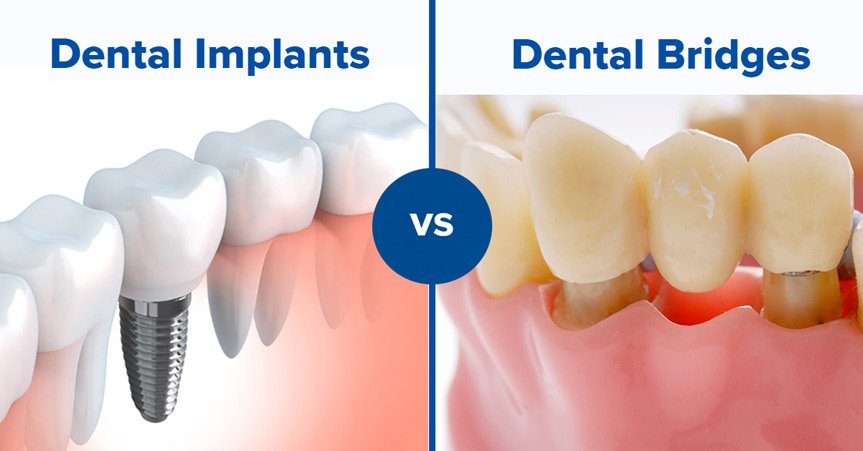St. Lawrence Dentistry makes every effort to save compromised teeth. However, sometimes it is necessary to remove a tooth and replace it with a dental prosthetic.
Two main ways of replacing a missing tooth are a dental implant or a fixed bridge. A dental implant is a titanium screw implanted into the jaw bone on which a porcelain tooth connects. A dental bridge involves ‘crowning’ two teeth on either side of the missing tooth. They are joined together by a “pontic”, which fills in the missing space. Both have advantages and disadvantages, and it is essential to make an informed decision about which best suits your situation.
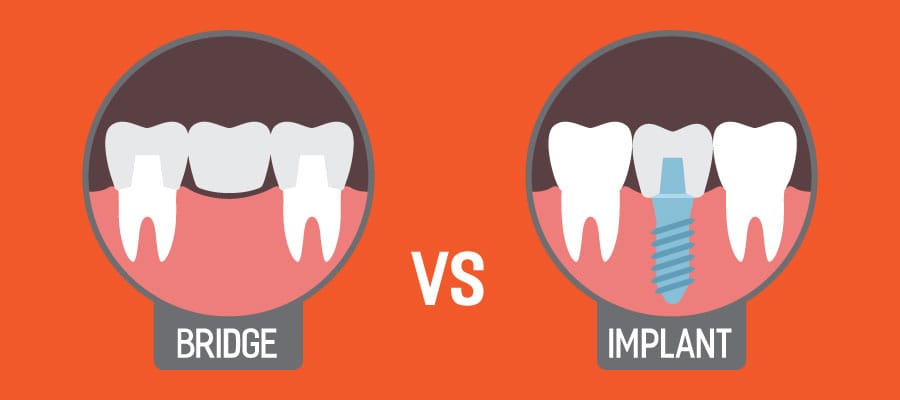
Please visit us here to learn more about dental implants:
What Are Dental Implants Mississauga On
Treatment Time
A bridge is typically a much faster treatment to perform than the implant restoration process. After tooth removal, the socket should heal for 2-3 weeks until the jaw and gums have finished their post-extraction remodeling. During this interim period, Dr. Hawryluk can place a temporary bridge. Recently, with our new Trios Scanning technology, there is 1-2 days less wait time to make a bridge since your “virtual bridge impression” is instantly sent to the dental lab by email. Then, the dental bridge fabrication can begin, and typically two weeks later, the bridge will be ready to insert. Implant treatment, on the other hand, can take many months to attain the final result. Sometimes after tooth removal, we wait four months to place the implant. Then the implant can take an additional four months to integrate with the bone. However, there are situations where an implant placement can be the same day as the tooth extraction – immediate implant placement. Dr. Hawryluk can assess whether you are a candidate for this technique.
To learn more about scanning technology, please visit here:
Digital Technology: The New Core Of Modern Dentistry
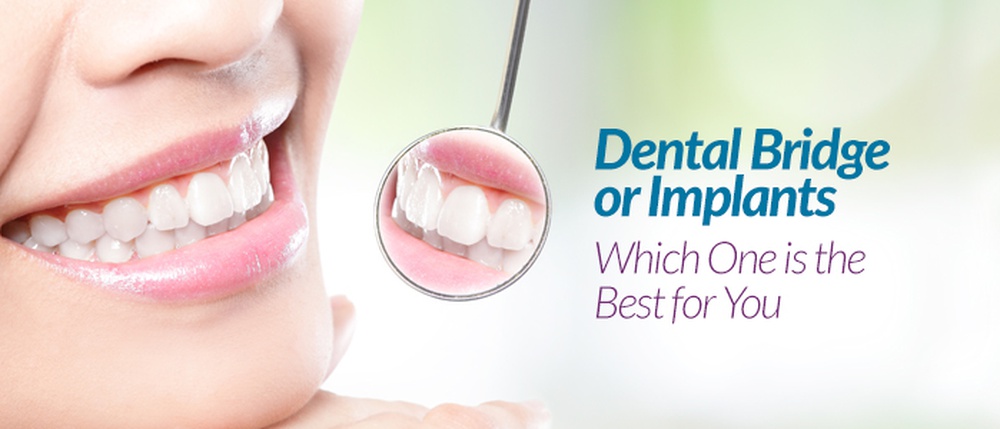
Involvement of adjacent teeth
One of the main advantages of dental implants is that they are standalone structures that do not involve adjacent teeth shaving>. A bridge, however, consists of preparing crowns on the adjacent teeth. In other words, a lot of shaving of the adjacent teeth takes place to make room for the bridge. Sometimes, adjusting the teeth down can irritate the tooth nerve, prompting root canal treatment. This unplanned but potential further treatment is a drawback of dental bridge treatment. If two teeth on either side of a bridge are in pristine shape, then implant placement is generally more favorable, so they are not touched. However, if the two adjacent teeth need dental crowns or already have root canal treatment, the bridge option may be more attractive. A bridge is only as strong as the teeth supporting it. Hence, we must consider the bone support around the adjacent teeth when planning a tooth replacement. If the adjacent teeth have bone loss around them, then a bridge is more likely to fail. In this case, a dental implant would be a better option.
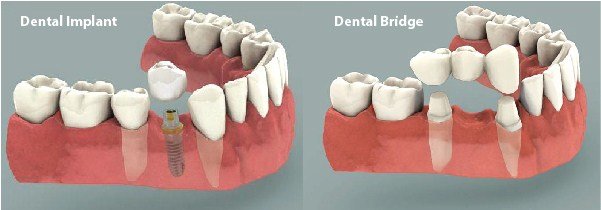
Surgery versus no surgery
Dental implant placement is a minor surgery, whereas the installation of a bridge is not. Some patients do not undergo a surgical procedure, or their medical history may contraindicate it. In these cases, the dental bridge can be the best option. If there is enough bone to place an implant, then the minor surgery is well within most patients’ comfort zone. Many patients are pleasantly surprised about the ease of implant placement. However, sometimes there is insufficient bone, and additional surgical procedures are needed. These include bone grafts like a sinus lift or ridge augmentation. In general, the more needed ancillary dental procedures to place an implant, the more patients will want to explore other ways of filling in a missing tooth. Dr. Hawryluk will make a full diagnosis before starting any work and inform you if additional procedures could be needed. Implant surgery is now much more straightforward due to the modern “guided surgery” techniques Dr. Hawryluk uses.
To learn more about guided implant placement, please visit here:
BioHorizons Guided Implant Surgery
Particulate Grafting
Only about 50% of a tooth extraction socket will naturally fill in with new bone after tooth removal. The rest will resorb, resulting in less bone mass for your jaw. Socket grafting is the placement of particulate bone in the extraction socket, which acts as a scaffold for new bone to form. When placing bone particulate, you can sometimes preserve close to 100% of your jaw structure. Dr. Hawryluk always recommends socket grafting when planning a dental implant. We want to embed the implant in as much bone as possible. It is also lovely to graft a socket if planning a dental bridge. However, it is not as important. The advantage of grafting before a dental bridge is the pontic tooth will not have to be made as long (to touch the gum/bone), and you will end up with a more anatomically correct tooth replacement.
To learn more about dental socket preservation, please visit here:
Dental Extraction Socket Preservation
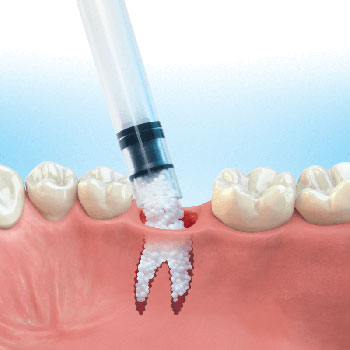
Expense
A dental implant is more expensive than a dental bridge. The main reasons are that materials, radiology fees, and commercial lab fees are higher for dental implants. Many new implant companies offer less expensive implant materials imitating well-known implant brands. Some of these can be quite good, but our office only uses premium brand implants from innovative companies such as BioHorizons. Radiology fees can be high for implant placement because modern techniques dictate a CT image to place a dental implant properly. A bridge does not require advanced CT imaging. Also, the fees for particulate grafting discussed above add to the expense of dental implants. Many patients have partial insurance coverage for dental bridges but do not for implants. Before undertaking any treatment, St. Lawrence Dentistry will give you an accurate cost comparison between these options and also factor in your specific insurance coverage. If you live in Ontario, Canada, sometimes Dr. Hawryluk can help you get your dental implant partially covered by your insurance provider through an alternate benefit clause. Your insurance may give you the amount you would have received for a dental bridge credited towards a dental implant. Usually, the insurance providers will stipulate that they will not cover any work on the adjacent teeth for five years. It is essential to know that your insurance may state they will not dispense any reimbursement funds until the implant crown placement (usually four months after the implant body’s surgical installation). We have been through the process of helping out Mississauga patients obtain the “alternate benefit” from their insurance carrier many times and would be happy to help you.
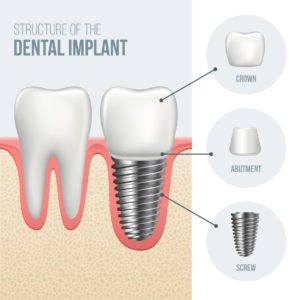
Homecare maintenance
An implant is a standalone dental prosthetic; you can floss it just like any other tooth. A fixed bridge requires a floss threader, which is more time-consuming. If you compare the difference in oral home care time over several years, an implant takes substantially less time to maintain.

As you can see, there are advantages and disadvantages to these two types of treatment. St. Lawrence Dentistry will make sure you are fully informed and help you select the best treatment option. If you would like to learn more about Dental Implants or Bridges and live in the Mississauga/Toronto area, please give us a call.
- Understanding Dental X-Rays and Radiation: What You Should Know - January 13, 2025
- Happy New Year from St. Lawrence Dentistry! - December 30, 2024
- Understanding Dental Cupping on Molars: Causes, Prevention, and Treatment - August 14, 2024



